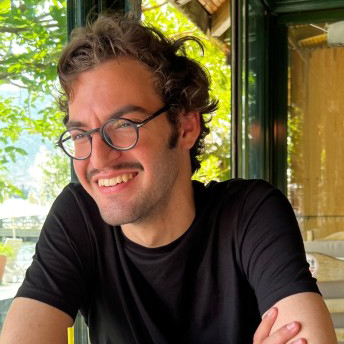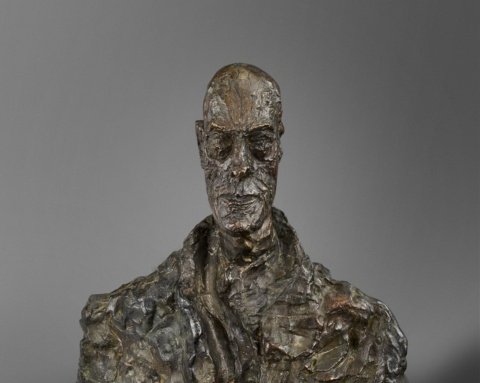Hart House supports student success and champions student leadership. The Warden’s Office and the Art Museum at the University of Toronto (AMUT) have always believed that U of T students can and should play a big role in acquiring works for the century-old Hart House Collection, one of North America’s oldest and continuous student-funded art collections.
“AMUT is responsible for the care of this collection. Without its staff providing expertise, guidance and a critical framework, the Hart House Collection would not be what it is today,” the Hart House’s manager of integrated arts education, Day Milman, explains.
She believes this is an excellent example of creating collaborative projects that benefit students and the general public. “Participating in the acquisitions process provides an unparalleled engagement opportunity for students,” she emphasizes. “They work directly with artists, curators and arts professionals within a supportive framework for participatory decision-making that impacts a major collection of Canadian contemporary art. We want to elevate, celebrate and promote the students’ invaluable work.”
An acquisitions co-chair of the Hart House Student Art Committee, Ali Eren Kaya, shares his story. A Laidlaw Scholar and member of New College, currently working on his degree in computer science and mathematics, Ali has been in this role since 2022. Interestingly, he has been coming to Hart House for a variety of activities, from improv class to using the fitness centre. “I’ve tried to utilize everything that Hart House has to offer,” he says.
Ali’s Interest in Art Began Early
Art captured Ali’s imagination at a young age. “I can’t think of a time when it wasn’t part of my life. I was obsessed with Leonardo da Vinci in primary school,” says the fourth-year student. “Also, my family collects Arabic calligraphy. So, at home, I was exposed to a certain type of collecting.”

Later, at U of T, Ali branched into contemporary art. He enjoyed a first-year course because it dovetailed into art. Here, he wrote a paper on the intersection of art and artificial intelligence.
By second year, Ali began investigating student initiatives. He noticed that although there are many art courses, there are few extracurricular, student-run opportunities. But Hart House’s committee seemed promising. “I started chatting with the executives on the acquisitions committee. They explained how it works … and I thought ‘Oh yeah, I’m submitting my application to the committee.’ It was accepted and I’ve had two amazing years.”
Rigorous Process for Acquiring Artwork
Working closely with Mona Filip, the AMUT curator who oversaw the acquisitions process, and coordinator, integrated arts education, Saša Rajšić, Ali notes that it felt like the group was starting fresh after the pandemic.
“The committee was revitalized, let’s say. Everyone learned from each other to build the process,” he explains. “We organized field trips to learn about the Toronto art scene. We contacted galleries, museums, art collectives and initiatives of all forms. We conducted informal interviews with curators to get a sense of what’s going on.”
The committee also began to refine processes: “Each student created a longlist of artwork to acquire. Saša also had some names in mind. From there, we consulted back with Mona at the Art Museum. In the initial meeting, we had tons of names. We wanted to dream big!”
The group also went through the Hart House Art Collection to identify any missing voices and/or media. In fact, this has been a focus for many years.
Students have a Voice
Ali appreciated the idea that students were shaping the historic collection; that they had a voice in the process. And in this, he felt a responsibility toward students, how they viewed political events and what kinds of topics they would deem a priority.
Slowly, the list of possibilities for acquisition was whittled down. From there, the students presented rationales for each artist. “This phase was a defense for why we should be acquiring this or that artist. We had a chance to talk about what we thought was a good choice and justify that choice,” Ali says. In doing so, committee members learned the formal process by which art is acquired and stewarded into a museum-level collection.
Voting also helped to make the final acquisition decisions.
As an International Student, This Means a Lot
The fact that he had a voice at the table when acquiring art for this historic permanent collection, meant a great deal to Ali. “I’m an international student, and I feel that I bring this wherever I am — a certain understanding of culture, reflexes, political reflexes — anything that I was before coming to U of T, I tried to maintain. I have a duty to all the other international students in terms of my presentation and understanding, because I feel like art is a tool or vehicle that provides a sense of self to the widest variety of people.
“For example, an international student might find a work of art on display at Hart House and see something in it that provides a sense of home to them, even though the object isn’t directly related to their past. Hart House does a good job of providing those spaces and contexts.”
Ali felt a sense of duty in creating this collection. “We try to keep our decisions in response to what we feel students are seeking in a space because we’re not just creating art at U of T. It’s more than that: This art is going to stay forever.”
“We welcome new students”
Ali suggests that interested students reach out. “Come to the events. You can interact with the committee chairs and talk about whatever you are curious about. Get involved with the decision makers in the acquisition process. We welcome new students warmly,” says the now former Acquisitions Co-Chair, adding, “It’s not exclusive.”

